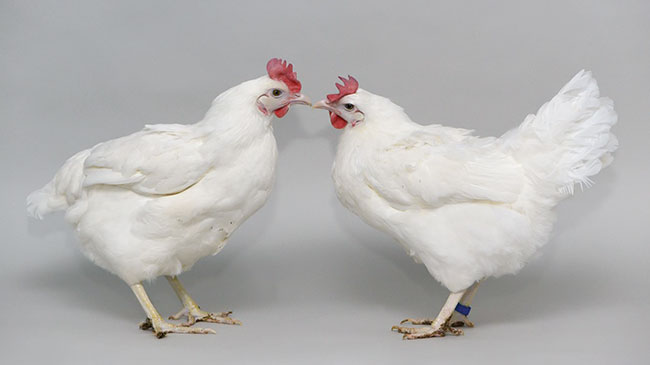
Genetic Editing: Path of resistance
By Melanie Epp
Features GeneticsIn a ground-breaking study, genetic editing showed it could potentially be a tool against avian influenza.
 A non-gene-edited chicken (left) pictured next to an ANP32A gene-edited chicken (right).
Photo: Norrie Russell
A non-gene-edited chicken (left) pictured next to an ANP32A gene-edited chicken (right).
Photo: Norrie Russell Scientists in the United Kingdom (UK) believe CRISPR technology could be the solution to preventing avian influenza outbreaks in chickens in the future. While results thus far look positive, much work still needs to be done – both in the lab and at the political level. The science, so far, has been positive, though.
Identifying the key gene
A team of scientists from three UK research institutes, the Roslin Institute, Imperial College London and the Pirbright Institute, recently completed a research project that looked at whether or not genome editing, a technique that subtly changes or edits the DNA of an animal, could make them alter the genes of chickens to make them resistant to avian influenza infections.
The project, which was funding by the UK government (the BBSRC), resulted in the discovery of a gene called ANP32. The gene ANP32A, when modified, partially safeguards chickens from avian influenza.
Targeting viral growth
Flu viruses are very small viruses and need to use the proteins of their infected host cell to be able to grow and make more viruses, explains Mike McGrew
“Our colleagues at Imperial discovered that one of the chicken host proteins used by the flu virus is ANP32A,” he says. “At first, we didn’t want to completely remove the ANP32A protein. We thought that by changing the protein very subtly, changing two amino acids of the protein, the flu virus would not be able to interact with ANP32A and grow in the cell.”
If virus is not able to grow in a cell, it will not be able to grow in the whole animal, McGrew adds.
According to the study, once gene-edited chickens were introduced to the viral challenge, nine out of 10 cells showed no viral growth.
“This was extremely good finding and suggested that we stopped all viral growth in the chickens,” says McGrew. “We were very encouraged by this result.”
Challenges and breakthroughs
One of the challenges the researchers faced involved breakthrough cases. Since the flu virus can jump from birds to pigs and humans, they needed to be sure that the virus would not mutate and adapt to grow in chicken cells with the genetic change. This could result in mutated flu virus that has more potential to cause disease in chickens, pigs and humans. Flu, like coronavirus, is an RNA virus that mutates incredibly rapidly. For this reason, the researchers challenged the chickens with 1,000 times the original dose. This allowed the flu virus more time to grow and divide in the chicken, mutating as it divided until a genetic change occurred that permitted the virus to grow in the altered host cells.
“That is exactly what we observed when we used a higher dose,” McGrew says. “This means that our small genetic change in ANP32A is not sufficient to stop avian influenza from growing in chickens and potentially infecting other chickens.”

Researchers used gene-editing technology known as CRISPR to create chickens with resistance to AI.
Photo: Bill Oxford / getty images
Exploring multiple proteins
As part of the investigation, the researchers found two other proteins similar to ANP32A, called ANP32B and ANP32E. The virus can use these two proteins as host cells if ANP32A is not present. They are now investing if removing or changing all three proteins will make the chicken completely resistant to avian influenza. Gene-editing, if successful, will apply to all avian influenza variants.
“We tested many flu virus variants in cells and it seems that they all depend on the three ANP32 genes to grow,” says McGrew.
Road to implementation
Several things need to happen before gene-editing technology can be used as a tool in the fight against avian influenza. In the lab, researchers need to find a genetic change that makes chickens completely resistant to avian influenza. They hope that that editing out all three ANP genes will do this.
“We think that this genetic change will make the chicken completely resistant to avian influenza,” says McGrew. “However, this, of course, comes with the caveat that the chickens need to remain healthy, happy, and productive with changes to all three genes.”
Politically, many countries will need to have more robust genome editing regulations in place so that gene-edited chickens can be sold to consumers in those countries.
“This is especially important for poultry as poultry is a global commercial product,” McGrew says.
McGrew expresses his regret that they cannot offer a flu-resistant chicken for poultry producers.
“We think that we are on the right pathway,” he says. “The progress is slow, as we need to raise funding for every step of the research process, but we do believe that gene editing is a safe option to eliminate bird flu infections from chicken flocks.”
Expert perspectives
Christine Baes, chair of the Department of Animal Biosciences at the University of Guelph, called the study’s findings a “huge breakthrough”.
“But it’s not implementable tomorrow,” she says. “There needs to be a lot of work done. It’s exciting, and it’s cool. There’s probably another five to 10 years of research that has to go into this before we can actually implement it.”
The future of gene editing
Gene-editing technology has shown incredible promise when it comes to tackling some of livestock production’s biggest disease challenges. According to Baes, what’s hindering the Canadian agricultural industry from applying gene editing is regulatory in nature, not technical in nature.
“Gene editing is not a silver bullet,” she says. “You need to understand the genetic consequences of the trait. Otherwise unintended consequences are possible.”
McGrew and the team plan to continue their studies in the coming years.
A breakthrough against avian influenza
Researchers in the UK, armed with CRISPR technology, are making strides in the battle against avian influenza outbreaks in chickens. Here are key takeaways from their initial results.
- Researchers in the UK leverage CRISPR to combat avian influenza outbreaks in chickens.
- ANP32A gene modification emerges as a key strategy for partial resistance.
- Challenges arise with higher viral doses, prompting exploration of proteins ANP32B and ANP32E.
- Global implementation faces hurdles, requiring robust genome editing regulations.
- Gene-editing technology shows transformative promise in livestock disease management.
- Experts stress the importance of understanding genetic consequences for effective application.
- Despite challenges, researchers anticipate a slow yet promising journey toward a flu-resistant chicken for producers.
Print this page